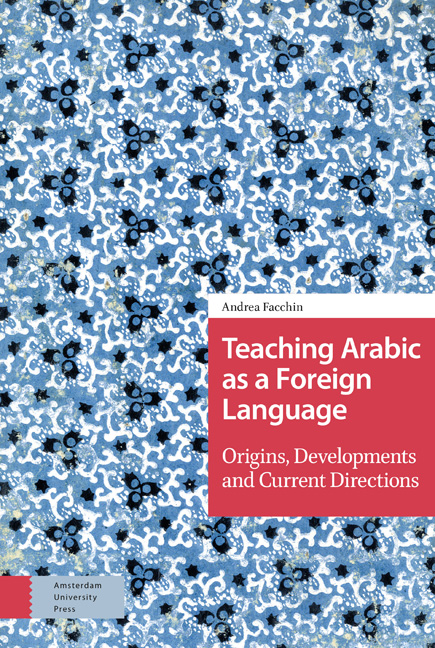Book contents
- Frontmatter
- Contents
- Acknowledgments
- Transliteration
- List of Abbreviations
- Arab World Map
- Introduction
- 1 The Historical Background
- 2 The Birth of a New Branch
- 3 Growth (1970s)
- 4 Development (1980s)
- 5 New Challenges (1990s)
- 6 In the Twenty-first Century (2000-2010)
- 7 The Present Period
- Conclusions
- List of Events
- A TAFL Who's Who (1958-2018)
- TAFL Institutes (1958-2018)
- Tables
- Bibliography
- Index
- Frontmatter
- Contents
- Acknowledgments
- Transliteration
- List of Abbreviations
- Arab World Map
- Introduction
- 1 The Historical Background
- 2 The Birth of a New Branch
- 3 Growth (1970s)
- 4 Development (1980s)
- 5 New Challenges (1990s)
- 6 In the Twenty-first Century (2000-2010)
- 7 The Present Period
- Conclusions
- List of Events
- A TAFL Who's Who (1958-2018)
- TAFL Institutes (1958-2018)
- Tables
- Bibliography
- Index
Summary
This study has been a journey of discovery: on the one hand, there is the identification and examination of the origins, developments and current directions of the teaching of Arabic as a foreign language (TAFL), which started as a simple branch of applied linguistics, then turned into an independent field, faced new challenges and finally reached the status of a full-fledged discipline; on the other hand, there is also the exploration and discovery of a multitude of other related aspects, such as twentieth- and twenty-first-century events, social contexts, and political changes of the Middle Eastern region, while taking snapshots of the Arab world and its academic research environments over the last 60 years. Such background information has been included since TAFL, like language teaching in general, follows the pendulum swings of history, politics and societal changes; hence, representing essential aspects that cannot be omitted as they provide a better understanding of the different research contexts.
The study initiates with the assumption that some Arab countries were more important than others in the field of TAFL. Thus, special attention was paid to three Arab nations, namely Tunisia, Egypt and Saudi Arabia, which have definitely played a key role in the development of the discipline. Nonetheless, after an accurate examination of the references, the research was extended to the whole Arab world – and even in part outside its boundaries – since debates and scholarly publications were sometimes interlaced with one another and had to be analyzed in a much wider context. North America, Europe, Southeast Asia and South America were taken into consideration, though no up-close examination was carried out since literature is already abundant in country-specific historical analyses and focuses (e.g., Abboud 1968; Kalati 2003, 2004; Amara 2006; Anghelescu; Hee-Man and El-Khazindar; Ryding 2006b, 2018; Gomes De Araújo; Sirajudeen and Adebisi; Akar; Sumi and Sumi). Therefore, this study aims to provide a historical overview as thorough as possible on the evolution of TAFL within the Arab world and partially outside of it between 1958 and 2018. The last 60 years have been fully described decade after decade in six different chapters (2 to 7), which were preceded by a historical background (Chapter 1) clarifying the situation before the birth of TAFL as a research area and giving readers the historical contexts of today's trends.
- Type
- Chapter
- Information
- Teaching Arabic as a Foreign LanguageOrigins, Developments and Current Directions, pp. 227 - 236Publisher: Amsterdam University PressPrint publication year: 2019



